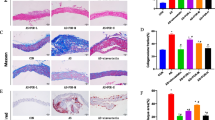Abstract
Objective
To explore the correlation between Fc γ RIII A (CD16A) and aortic atherosclerotic plaque destabilization in apoE knockout (apoE KO) mice and the intervention effects of effective components of Chuanxiong Rhizome and Red Peony Root.
Methods
Eight 8-week-old male C57BL/6J mice were selected as the control group. Forty 8-week-old male apoE KO mice were randomly divided into the model group, apoE KO + intraperitoneal injection immunoglobulin group (IVIG), apoE KO + simvastatin group (Sm), apoE KO + high dosage of Xiongshao Capsule (XSC, 芎芍胶囊) group (XSCH), and apoE KO + low dosage of XSC group (XSCL), 8 mice in each group. Mice in the control group were put on a normal diet, and others were fed with a high-fat diet. After 10-week different interventions, monocyte CD16 expression was detected by flow cytometry, aortic matrix metalloproteinase-9 (MMP-9) mRNA expression was detected using reverse transcriptionpolymerase chain reaction, and serum tumor necrosis factor (TNF)-α level was detected using enzyme-linked immunosorbent assay.
Results
Compared with the control group, monocyte CD16 expression, aortic MMP-9 mRNA expression, and serum TNF-α level in the model group increased obviously (P<0.01). Injections of apoE KO mice with intraperitoneal immunoglobulin during a 5-day period significantly reduced the monocyte CD16 expression, aortic MMP-9 mRNA expression, and serum TNF-α level (P<0.01 or 0.05) over a 10-week period of high-fat diet. Indices above in the Sm group, XSCH group, and XSCL group decreased in a different degree. Of them, the aortic MMP-9 mRNA expression in XSCH group was lower than that in Sm group (P<0.05) and the monocyte CD16 expression and serum TNF-α level showed no significant difference between XSCH group and Sm group (P>0.05). Correlation analyses suggested positive correlation between monocyte CD16 expression and aortic MMP-9 mRNA expression or serum TNF-α level in IVIG group, XSCH group, and XSCL group.
Conclusions
FcγR III A mediates systemic inflammation in the progression of coronary heart disease with blood stasis syndrome. XSC could stabilize atherosclerotic plaque by suppressing inflammation and its target was relative with FcγRIII A.
Similar content being viewed by others
References
Ma XJ, Yin HJ, Chen KJ. Differential gene expression profiles in coronary heart disease patients of blood stasis syndrome in traditional Chinese medicine and clinical role of target gene. Chin J Integr Med 2009;15:101–106.
Ivan E, Colovai AI. Human Fc receptors: critical targets in the treatment of autoimmune diseases and transplant rejections. Hum Immunol 2006;67:479–491.
Apple FS, Wu AH, Mair J, Ravkilde J, Panteghini M, Tate J, et al. Future biomarkers for detection of ischemia and risk stratification in acute coronary syndrome. Clin Chem 2005;51:810–824.
Johnson J, Carson K, Williams H, Karanam S, Newby A, Angelini G, et al. Plaque rupture after short periods of fat feeding in the apolipoprotein E-knockout mouse: model characterization and effects of pravastatin treatment. Circulation 2005;111:1422–1430.
van Bochove GS, Straathof R, Krams R, Nicolay K, Strijkers GJ. MRI-determined carotid artery flow velocities and wall shear stress in a mouse model of vulnerable and stable atherosclerotic plaque. MAGMA 2010;23:77–84.
Johnson J, Carson K, Williams H, Karanam S, Newby A, Angelini G, et al. Plaque rupture after short periods of fat feeding in the apolipoprotein E-knockout mouse: model characterization and effects of pravastatin treatment. Circulation 2005;111:1422–1430.
Livak KJ, Schmittgen TD. Analysis of relative gene expression data using real-time quantitative PCR and the 2-[Delta Delta C(T)] method. Methods 2001;25:402–408.
Masuda A, Yoshida M, Shiomi H, Morita Y, Kutsumi H, Inokuchi H, et al. Role of Fc receptors as a therapeutic target. Inflamm Allergy Drug Targets 2009;8:80–86.
Gavasso S, Nygard O, Pedersen ER, Aarseth JH, Bleie O, Myhr KM, et al. Fc gamma receptor III A polymorphism as a risk-factor for coronary artery disease. Atherosclerosis 2005;180: 277–282.
Stefanou DC, Asimakopoulos G, Yagnik DR, Haskard DO, Anderson JR, Philippidis P, et al. Monocyte Fc gamma receptor expression in patients undergoing coronary artery bypass grafting. Ann Thorac Surg 2004;77:951–955.
Abe J, Jibiki T, Noma S, Nakajima T, Saito H, Terai M. Gene expression profiling of the effect of high-dose intravenous Ig in patients with Kawasaki disease. J Immunol 2005;174: 5837–5845.
Kawanaka N, Nagake Y, Yamamura M, Makino H. Expression of Fc gamma receptor III (CD16) on monocytes during hemodialysis in patients with chronic renal failure. Nephron 2002; 90:64–71.
Libby P, Ridker PM, Maseri A. Inflammation and atherosclerosis. Circulation 2002;105: 1135–1143.
Samuelsson A, Towers TL, Ravetch JV. Anti-inflammatory activity of IVIG mediated through the inhibitory Fc receptor. Science 2001;291:484–486.
Johnson JL, George SJ, Newby AC, Jackson CL. Divergent effects of matrix metalloproteinases 3, 7, 9, and 12 on atherosclerotic plaque stability in mouse brachiocephalic arteries. Proc Natl Acad Sci USA 2005;102:15575–15580.
Stefanadi E, Tousoulis D, Papageorgiou N, Briasoulis A, Stefanadis C. Inflammatory biomarkers predicting events in atherosclerosis. Curr Med Chem 2010;17:1690–1707.
Chen KJ, Shi DZ, Xu H, Lu SZ, Li TC, Ke YN, et al. XS0601 reduces the incidence of restenosis: a prospective study of 335 patients undergoing percutaneous coronary intervention in China. Chin Med J 2006;119:6–13.
Author information
Authors and Affiliations
Additional information
Supported by the National Key Basic Research and Development Program of China (No. 81073086)
Rights and permissions
About this article
Cite this article
Huang, Y., Yin, Hj., Ma, Xj. et al. Correlation between Fc γ R III a and aortic atherosclerotic plaque destabilization in ApoE knockout mice and intervention effects of effective components of Chuanxiong Rhizome and Red Peony Root . Chin. J. Integr. Med. 17, 355–360 (2011). https://doi.org/10.1007/s11655-011-0726-y
Received:
Published:
Issue Date:
DOI: https://doi.org/10.1007/s11655-011-0726-y




